Of all the colors that stand out in the garden, I think chartreuse is one of the most noteworthy.
Wood sorrel, though often a humble citizen, will reliably spread lime green joy throughout the garden. The cheerful flowers in white, yellow, pink, and purple are practically an aside.
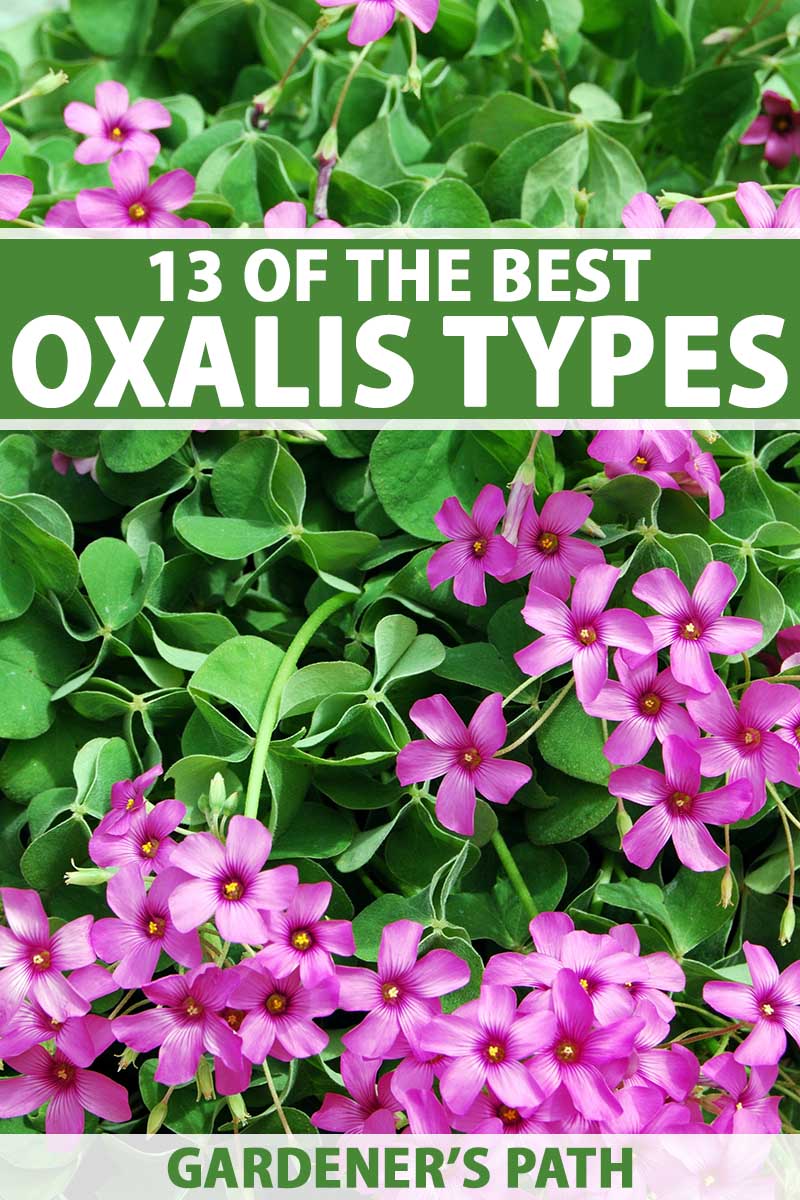
We link to vendors to help you find relevant products. If you buy from one of our links, we may earn a commission.
Oxalis is a fascinating genus. It has some pretty interesting characteristics, like the fact that the seeds of these plants are violently ejected once they’re ripe, via a mechanism known as explosive dehiscence.
They also exhibit nyctinasty. Most gardeners are familiar with this behavior in the prayer plant (Marantaceae). It’s when the leaves of a plant fold up at night or on cloudy days.
Oxalis species all have a generally similar appearance, with triangular leaves in groups of three, tuberous roots, and five-petaled flowers. But within the genus there is quite a range of characteristics.
Some plants never grow more than four inches tall and others reach two feet. Flowers can be small and lilac or large and yellow.
The leaves are usually lime green, but you can find some in the deepest shades of purple, or a variegation of the two as well. There is even a species grown solely for its edible root.
Ready to learn about some of the best of these underappreciated plants? Here are the species we’ll talk about in this roundup:
13 of the Best Oxalis Species
- Acetosella
- Articulata
- Corniculata
- Corymbosa
- Deppei
- Grandis
- Montana
- Purpurea
- Stricta
- Triangularis
- Tuberosa
- Versicolor
- Violacea
Of course, there are far more species than what we’re covering here. All told, there are over 500 wood sorrels, sourgrasses, and false shamrocks, as these plants are often called.
The ones described below are just some of the best for cultivation in North American gardens.
Speaking of, be aware that location is everything when it comes to Oxalis. A species that will be perfectly mild mannered and welcome in one area can be a downright nuisance in another.
Without further ado, let’s talk about these plants.
1. Acetosella
Common wood sorrel (O. acetosella) is just that: common. It grows wild all over the place in the Northern Hemisphere from Russia throughout Europe and across North America.
In the US it does best in USDA Growing Zones 3 to 7, in full shade to full sun.
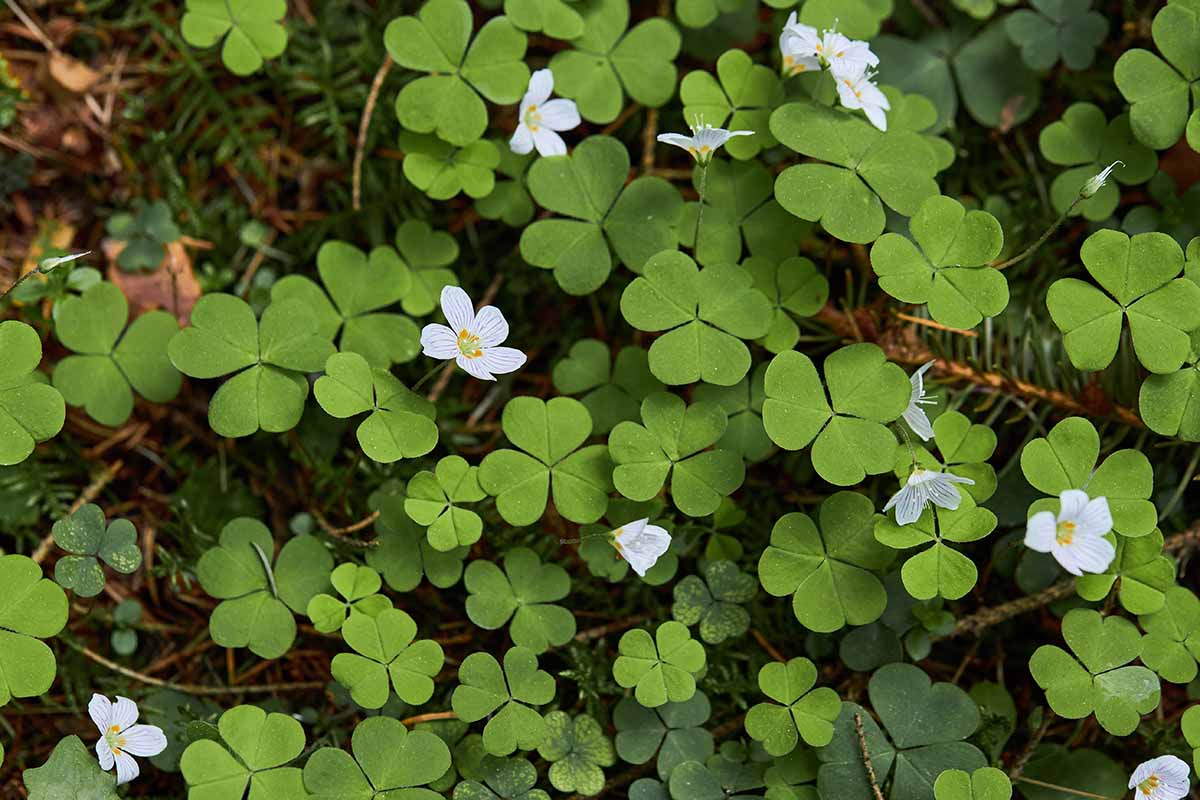
It has petite clover-like leaves with three heart-shaped leaflets that are creased down the middle. As with other plants in the genus, the leaves fold up at night, along with the flowers.
This species is often used as a shamrock during the St. Patrick’s holiday and it’s also eaten in the many regions where it grows wild.
Reaching a mature height of only about four inches tall, O. acetosella can spread rapidly, making it an ideal ground cover. It can even withstand some foot traffic, so you can use it as a lawn replacement or plant it between pavers.
The springtime blooms are typically white with faint pink streaks, but the flowers are sometimes fully pink instead.
2. Articulata
Pink wood sorrel (O. articulata) is the belle of the Oxalis ball.
The bright pink, relatively large flowers blanket the plant for a good portion of the spring and summer. Each blossom is three-quarters of an inch in diameter and there are lots of them.
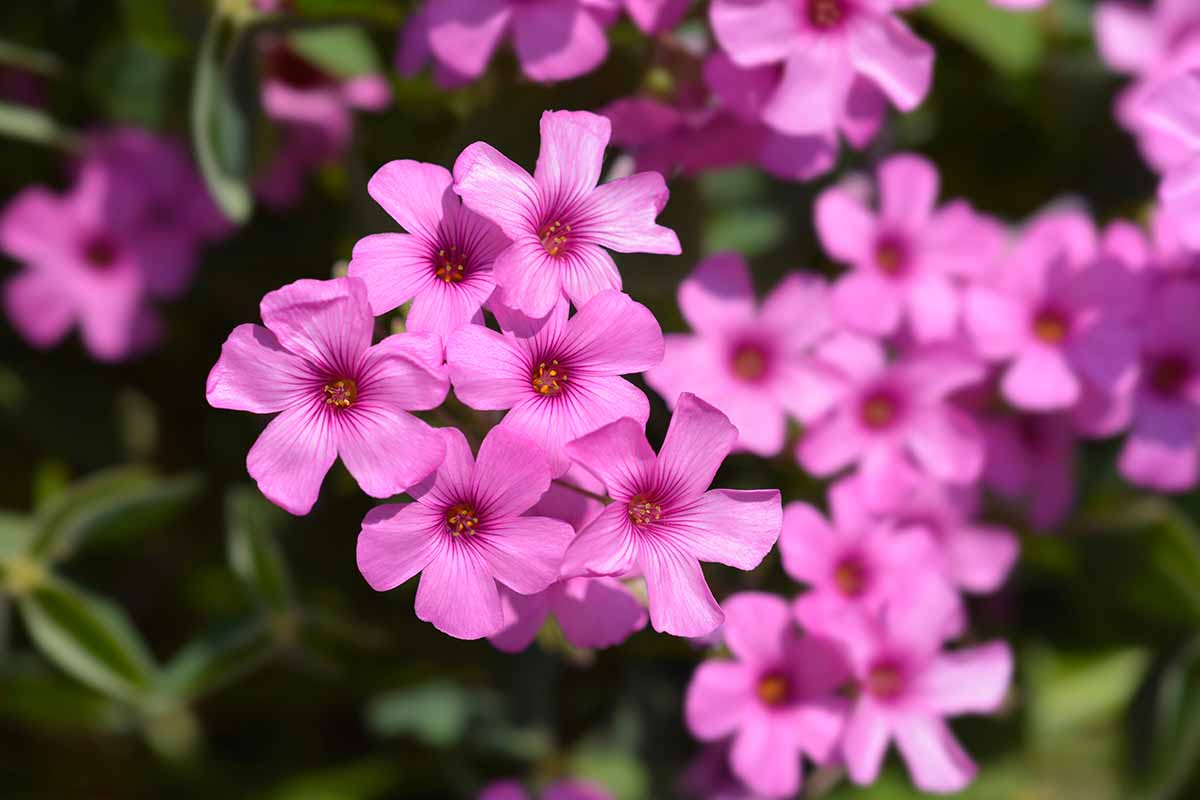
The plant only grows to about 10 inches, so it makes a perfect ground cover in full sun or part shade areas.
While it’s a vigorous grower, it doesn’t become invasive in most locations, though it has naturalized in parts of California. It grows best in Zones 6 to 11.
The rubra subspecies is nearly identical except that it has reddish-pink flowers.
3. Corniculata
I was kindly invited one time to enjoy a holiday meal with a family from south India and they shared sour fish curry made with creeping wood sorrel (O. corniculata) that I still dream about. It was spicy, pungent, citrusy magic.
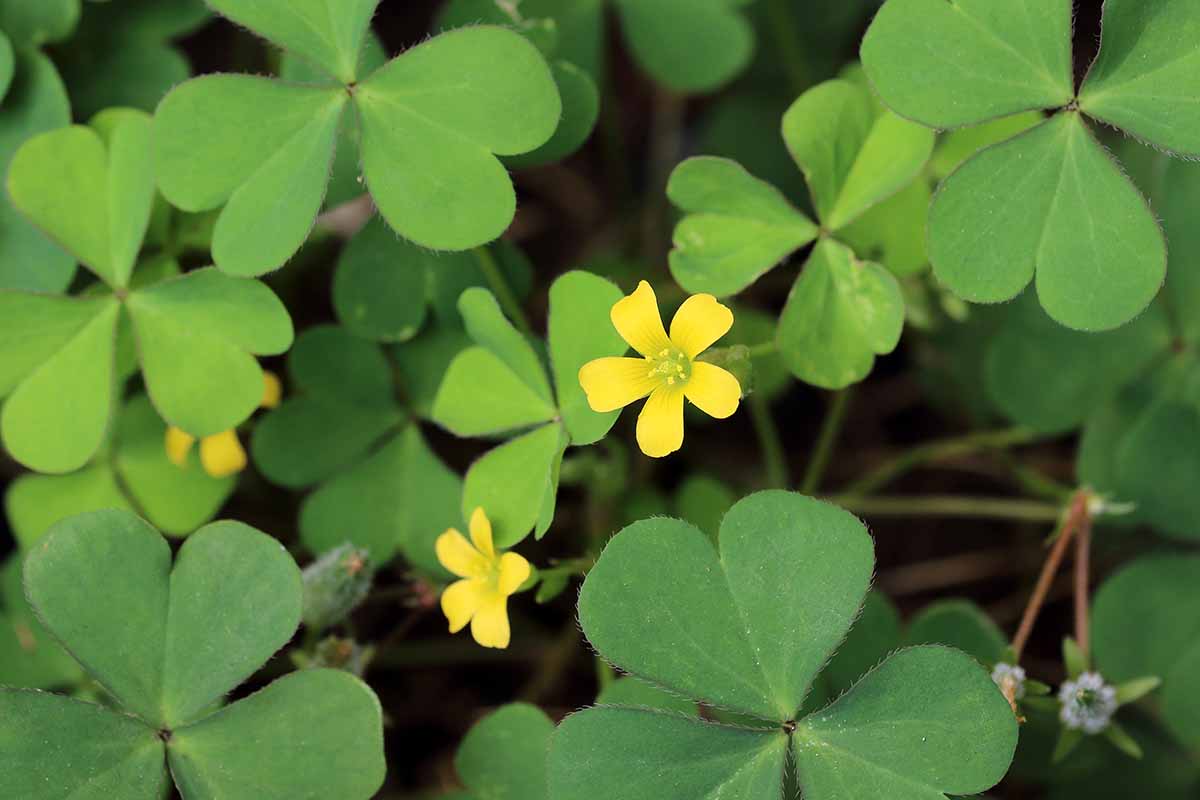
Obviously, you can make sour fish curry without wood sorrel, but I’ve never been able to (nearly) recreate the perfect combination of flavors without it.
In Italy, creeping wood sorrel is made into a citrusy drink by boiling the leaves, straining, cooling the liquid, and adding sugar and ice.
The greens aren’t nearly as popular in North America as they are in other parts of the world and they’re only available in stores for part of the year, so buy yourself a plant and grow some in your own garden instead!
Creeping wood sorrel has a more sour and citrusy flavor than many other types.
Even if you don’t intend to eat it, the yellow flowers and trio of heart-shaped leaflets are a nice addition to the garden. The purple variety (O. corniculata var. atropurpurea) is especially attractive.
The plant can grow up to eight inches tall and does best in Zones 4 to 8 in full to partial sun.
4. Corymbosa
This species is technically categorized as a variety of O. debilis, but you’ll often see O. corymbosa mislabeled as its own species.
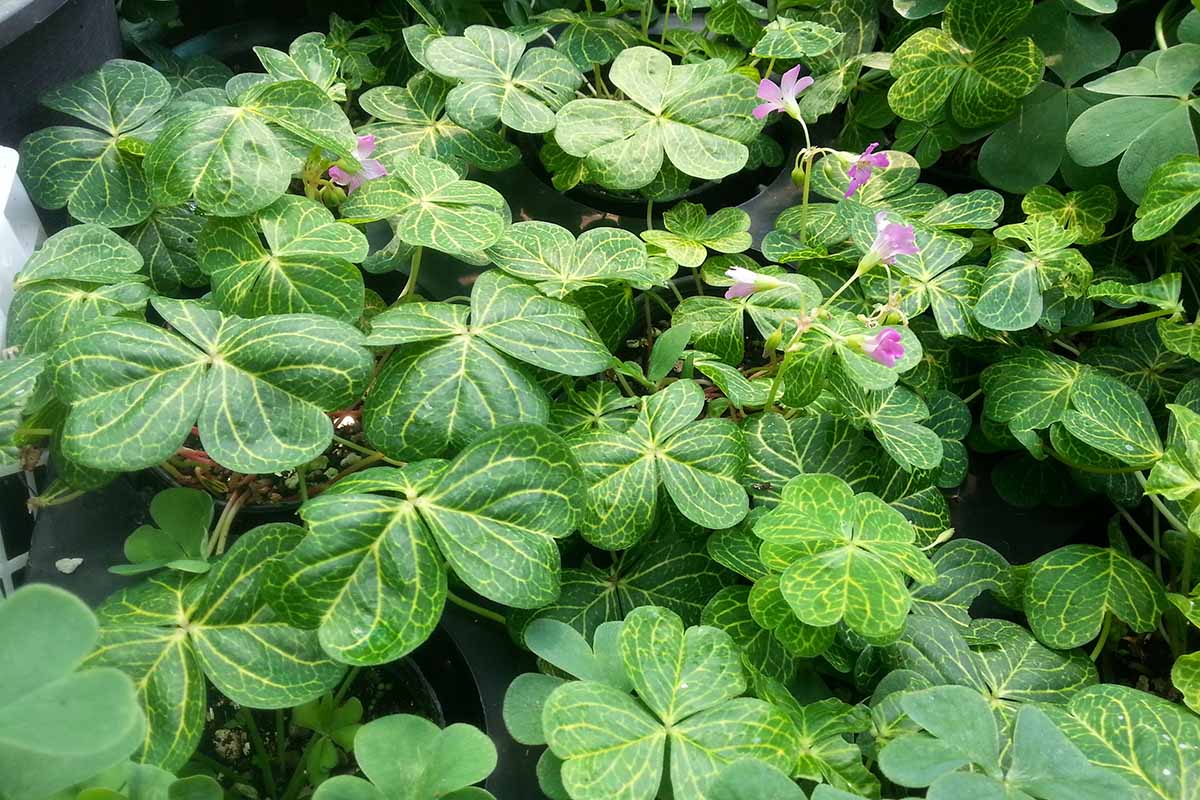
It is a robust grower (you might even call it aggressive in some areas) with leaves featuring three triangular leaflets.
The pink or lavender flowers earned this plant the nickname “pink shamrock” or “pink wood sorrel.”
‘Aureo-Reticulata’ is a stunning cultivar of this variety. It has that characteristic small trio of leaflets that make up each leaf, but the veins are bright golden-yellow. The pink blossoms in the spring are just an added bonus.
Plants of this variety grow best in Zones 7 to 10 in full or partial sun and reach about nine inches tall.
You can find plants in three-inch pots available from Winter Greenhouse via Walmart.
5. Deppei
This species is probably most famous for the cultivar ‘Iron Cross,’ which has a distinctive dark purple mark at the base of the four leaves, lending it the appearance of a cross.
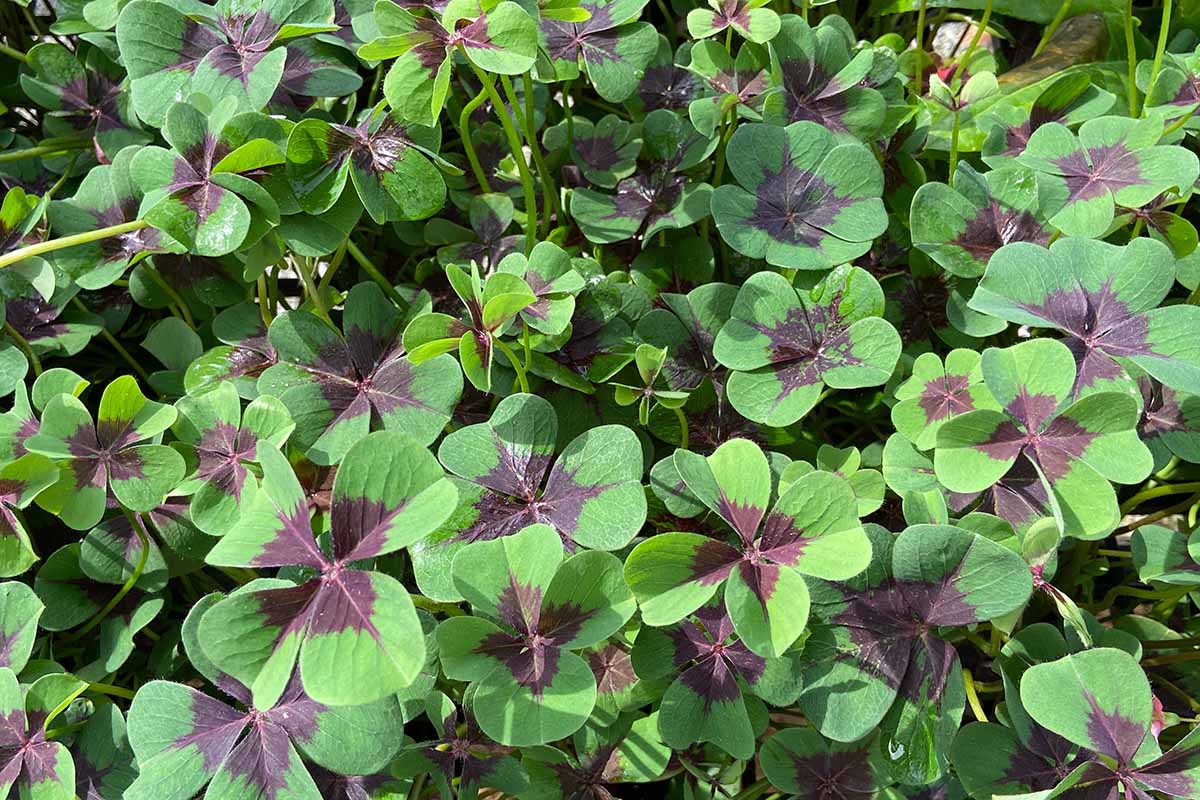
O. deppei (syn. O. tetraphylla) aka four-leaf sorrel is reliable and prolific, as well as being taller than many other species. It can reach up to a foot high in the right conditions.
Speaking of being robust, this one might even be too prolific in some areas.
It can grow rapidly and may appear in parts of the garden you don’t want it, so you’ll need to keep an eye on its spread.
Alternatively, grow it in a container as many people opt to do around St. Patrick’s Day.
Grow it as a perennial in Zones 7 to 10 or as an annual in Zones 3 to 7.

If you love the look of this plant, it’s available at Amazon in 20-corm packs.
6. Grandis
Great wood sorrel (O. grandis) is truly grand. Stretching all the way up to two feet tall, it’s one of the tallest species you can find. The inch-wide flowers are bright yellow with a spot of red at the base of each petal.
This species is native to the eastern United States, and while the flowers are undeniably lovely, even when the plant isn’t in bloom it’s eye-catching, with two-inch-wide lime green leaves.
Grow this big, bold plant in Zones 6 to 11 in full or partial sun.
7. Montana
Mountain wood sorrel (O. montana) is a charmer with its delicate white and lavender striped blossoms.
The bright green leaves add color to shaded areas, especially under conifers, and the flowers dot the plant throughout the summer.
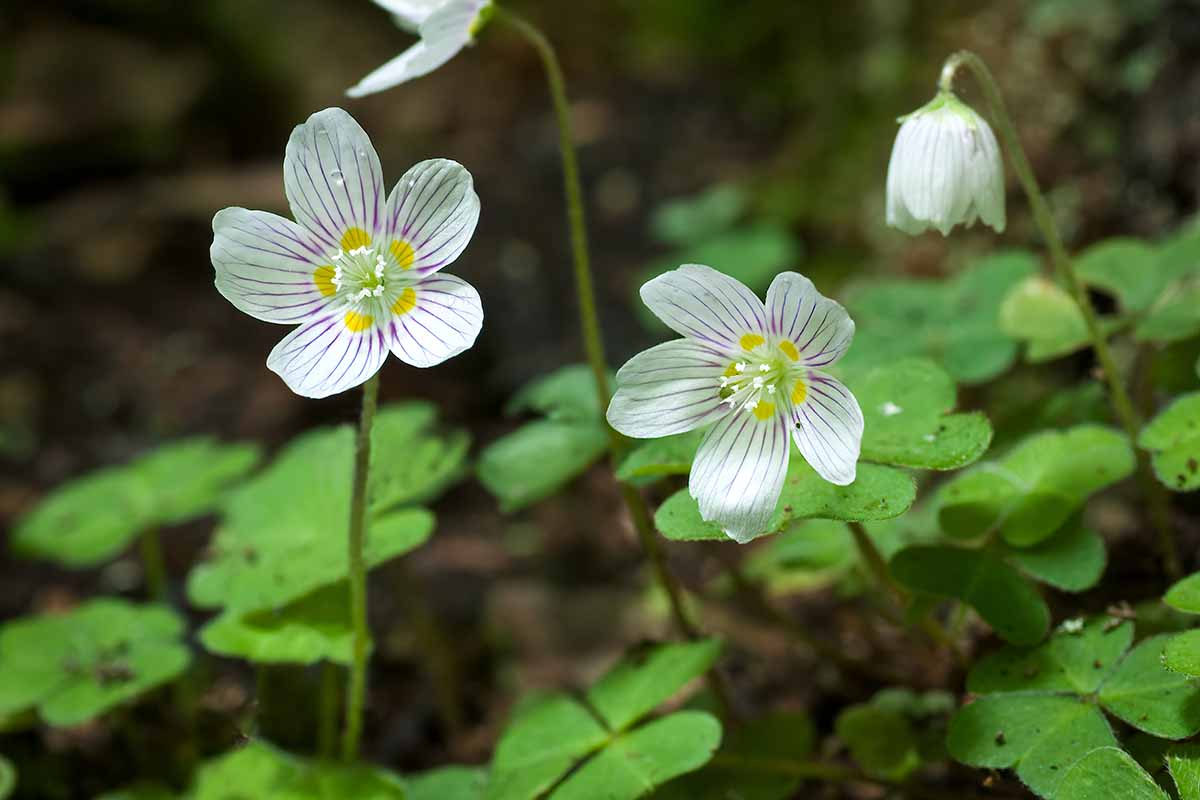
This six-inch-tall plant is found in cool, forested areas of eastern North America, and its retiring nature makes it all the more special.
If you want an Oxalis you can enjoy with no fear that it will break free and turn invasive, this should be among your top picks for Zones 6 to 10.
8. Purpurea
Purple wood sorrel (O. purpurea) has large, dark pink flowers that are pretty enough to make this plant worth growing for the blossoms alone.
The petite, heart-shaped trio of leaflets are merely a pretty backdrop for this South African native. And it only grows about five inches tall, so it’s perfect for replacing grass.
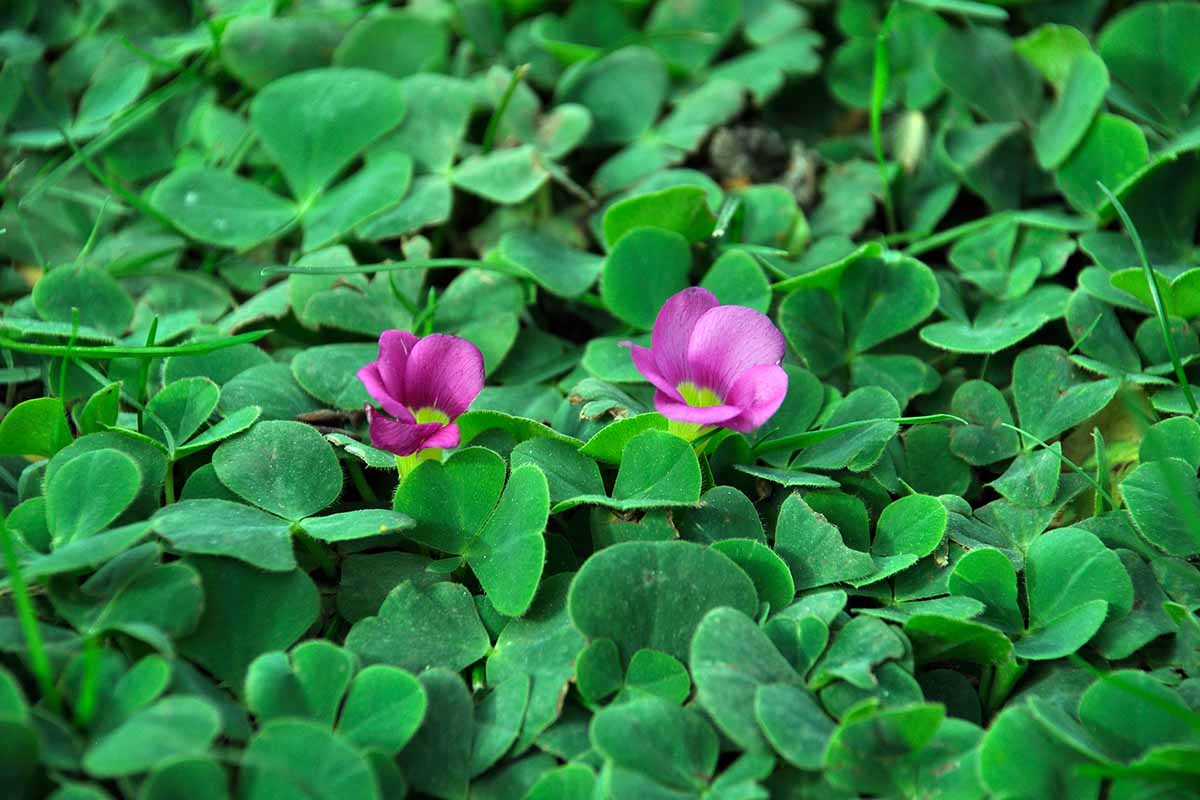
This plant grows well in Zones 9 and 10, but it will self-seed and reliably come back year after year in regions as cold as Zone 6. Just watch out – in the right conditions, it can become weedy.
It grows best in partial sun or shade, or you can plant some in pots indoors in a window with morning sun.
9. Stricta
Common wood sorrel (O. stricta) is a North American native that’s often considered a weed.
You’ll often hear about methods for getting rid of it from lawns and gardens. But if you’re looking for a lawn replacement, don’t fight it, let it grow!
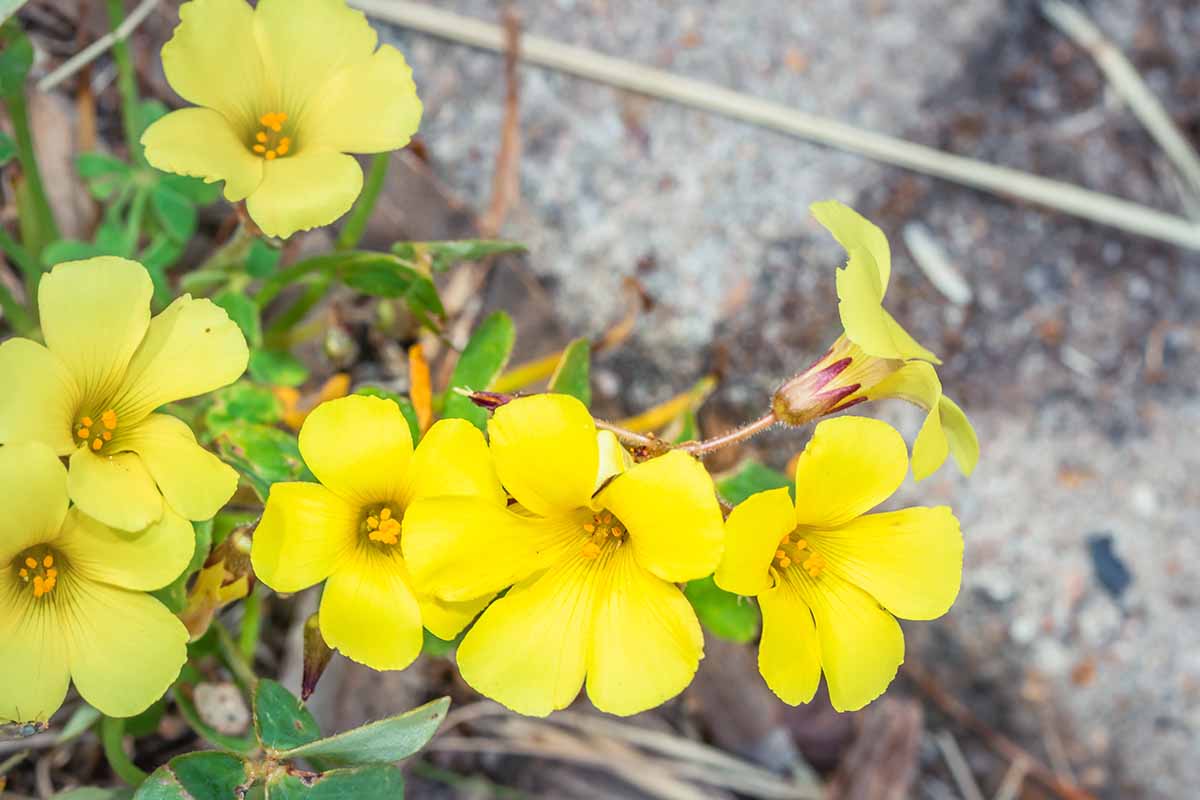
It tolerates low light better than most species grown as lawn replacements, and native pollinators love it. Plus, you can eat it.
The plant grows up to a foot tall and sends out cheerful yellow flowers in the spring.
It’s widely adapted and distributed, popping up from Zone 4 to 11 in full sun to shade.
10. Triangularis
With large, triangular leaflets that may be green, variegated, or dark purple, O. triangularis is one of the most common species in cultivation because it makes such a gorgeous shamrock for decorating.
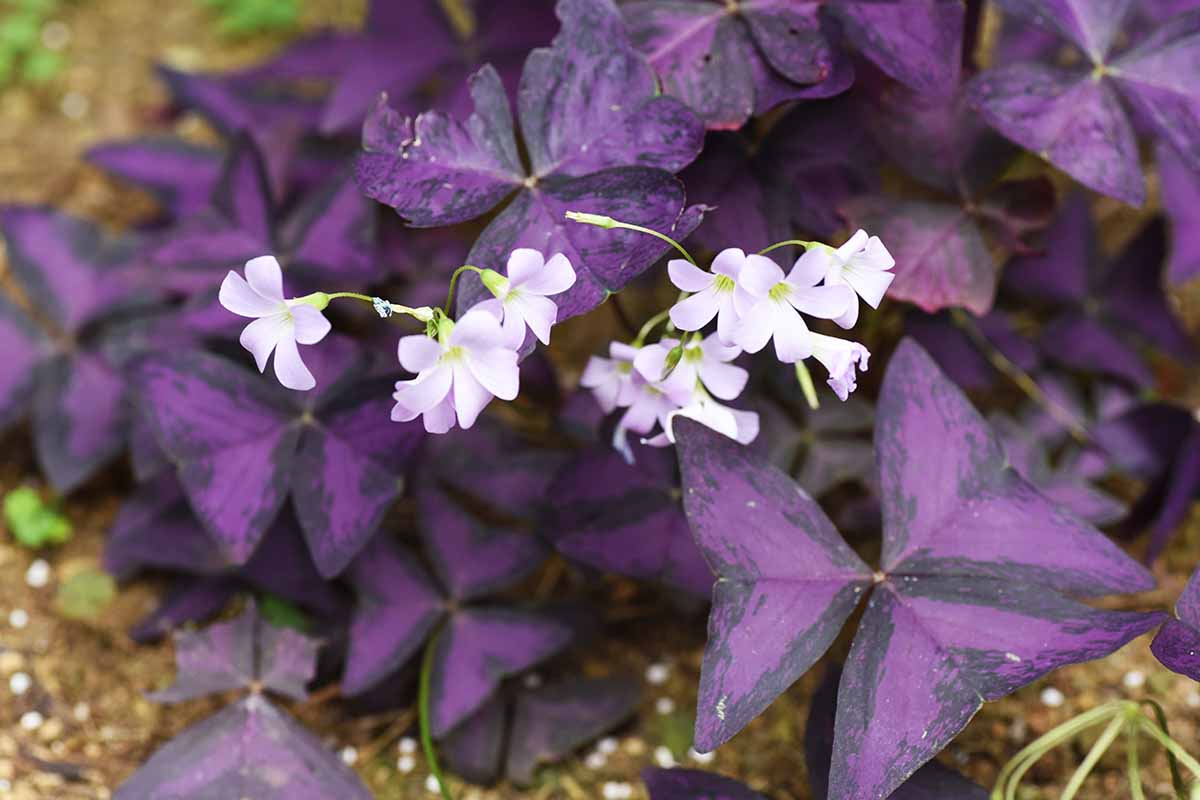
Commonly known as false shamrock and formerly classified as O. regnellii, you’ll see this type popping up in containers at stores and restaurants right around St. Patrick’s Day.
The ‘Atropurpurea’ cultivar of the papilionaceae subspecies is particularly stunning.
The triangular leaves are nearly black with a bright purple blotch in the center, and pale pink flowers bloom in the spring. It grows in Zones 7 to 10.
11. Tuberosa
You probably won’t pick this species for its ornamental value, but O. tuberosa is an excellent food source.
The tubers are cultivated throughout South America as a veggie, with cultivars available that feature yellow, orange, peach, pink, or red tubers.

You might have seen these tiny potato-like veggies for sale at specialty markets – they’re usually labeled “oca” in North America. Or if you live in New Zealand, where they’re readily available, you probably know them simply as yams.
The tubers are incredibly tasty. When cooked, they’re almost like a potato blended with sour cream. Raw, they have a more citrusy flavor.
Above ground, the plants produce small green leaves with three triangular leaflets each, which are also edible. The stems are pretty tasty, too, though you should cook them to reduce the bitterness.
O. tuberosa grows best in Zones 6 to 9, particularly in areas that have cooler summer temperatures. Depending on the cultivar, they usually grow between 12 and 24 inches tall.
12. Versicolor
O. versicolor is known as candy cane sorrel, and one look at the bold white and red blossoms and you’ll know why.

I think oxalis flowers are charming, but they aren’t exactly showy. Not so with O. versicolor. The blossoms are fuller, larger, and more colorful than other species.
O. versicolor native to South Africa, and grows up to six inches tall.
It blooms from late summer until the frost and will return year after year in Zones 7 to 9.
13. Violacea
This North American native, commonly called violet wood sorrel (O. violacea), is threatened in the wild in some areas, so do you part and cultivate away!
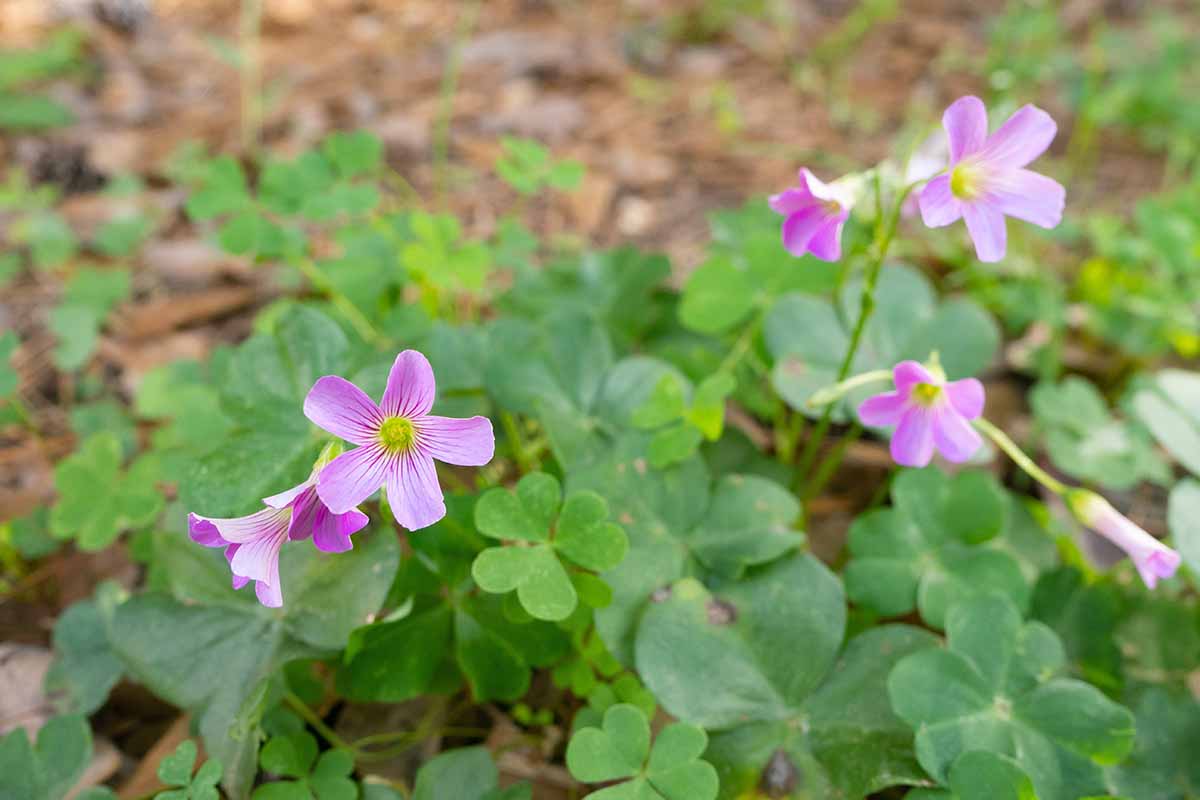
The vibrant pink and purple flowers with green throats start showing up in the spring and persist for months on the 16-inch plants.
While each half-inch-wide blossom is dainty, these appear in clusters of up to 19 individual flowers, making for a bigger impact.
This is the only type of violet-flowered Oxalis seen in many parts of the US, so count yourself lucky if you have it growing in the wild.
You can often purchase it at nurseries that specialize in native plants, but these aren’t very common in cultivation otherwise.
The mounds of chartreuse leaves and the purple blossoms are lovely in mass plantings or borders.
Oxalis Deserves More Love in the Garden
Gardening is dominated by trends. Flowers and other ornamentals come in and out of fashion as surely as the clothes walked down the Paris runways.
And Oxalis is one of those plants that has plugged away in the background, disregarded as a weed one year and cultivated as a shamrock for the holidays the next.
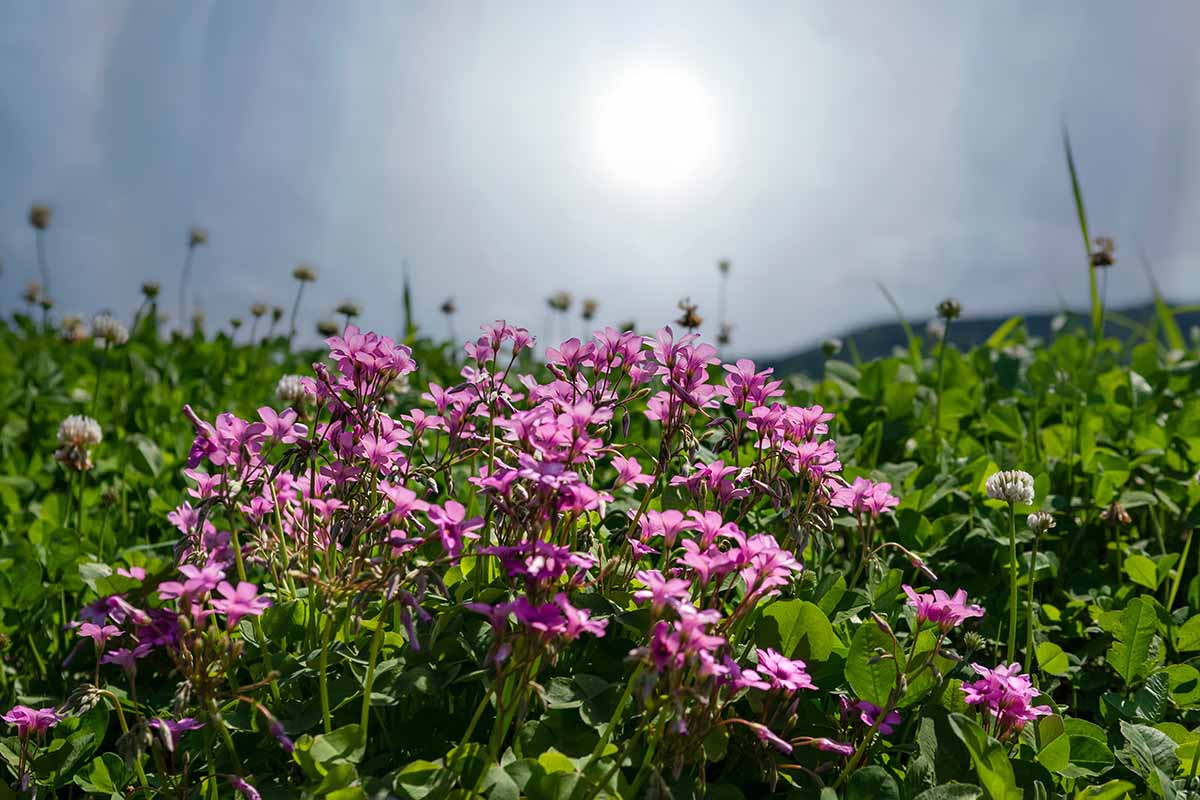
I think it’s time wood sorrel was given the spotlight, and the species featured on this list offer a fabulous place to start.
Did one of them catch your eye? Let us know which is your favorite in the comments section below.
Are you interested in learning more about growing oxalis? Check out these guides next:

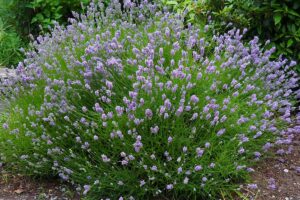


3 or four of them are familiar as I have rigorously weeded them out. I wish I hadn’t done that the purple (triangularis elsewhere from home) sorrel, the Corniculata (liked it’s sourness), the Deppei or iron cross, the white flowered one Acetculosa I don’t remember now.